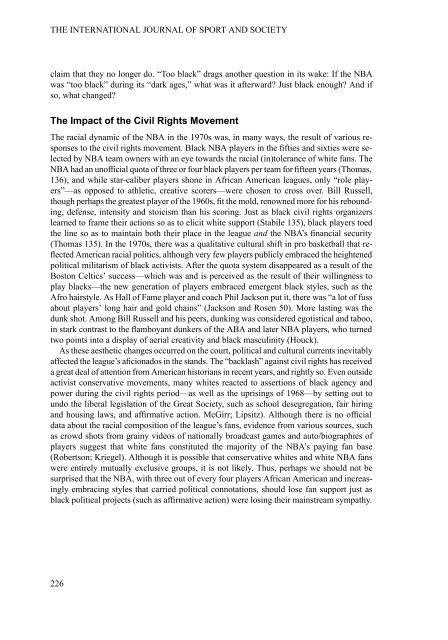Download - University of Minnesota
Download - University of Minnesota
Download - University of Minnesota
Create successful ePaper yourself
Turn your PDF publications into a flip-book with our unique Google optimized e-Paper software.
THE INTERNATIONAL JOURNAL OF SPORT AND SOCIETY<br />
claim that they no longer do. “Too black” drags another question in its wake: If the NBA<br />
was “too black” during its “dark ages,” what was it afterward? Just black enough? And if<br />
so, what changed?<br />
The Impact <strong>of</strong> the Civil Rights Movement<br />
The racial dynamic <strong>of</strong> the NBA in the 1970s was, in many ways, the result <strong>of</strong> various responses<br />
to the civil rights movement. Black NBA players in the fifties and sixties were selected<br />
by NBA team owners with an eye towards the racial (in)tolerance <strong>of</strong> white fans. The<br />
NBA had an un<strong>of</strong>ficial quota <strong>of</strong> three or four black players per team for fifteen years (Thomas,<br />
136), and while star-caliber players shone in African American leagues, only “role players”—as<br />
opposed to athletic, creative scorers—were chosen to cross over. Bill Russell,<br />
though perhaps the greatest player <strong>of</strong> the 1960s, fit the mold, renowned more for his rebounding,<br />
defense, intensity and stoicism than his scoring. Just as black civil rights organizers<br />
learned to frame their actions so as to elicit white support (Stabile 135), black players toed<br />
the line so as to maintain both their place in the league and the NBA’s financial security<br />
(Thomas 135). In the 1970s, there was a qualitative cultural shift in pro basketball that reflected<br />
American racial politics, although very few players publicly embraced the heightened<br />
political militarism <strong>of</strong> black activists. After the quota system disappeared as a result <strong>of</strong> the<br />
Boston Celtics’ success—which was and is perceived as the result <strong>of</strong> their willingness to<br />
play blacks—the new generation <strong>of</strong> players embraced emergent black styles, such as the<br />
Afro hairstyle. As Hall <strong>of</strong> Fame player and coach Phil Jackson put it, there was “a lot <strong>of</strong> fuss<br />
about players’ long hair and gold chains” (Jackson and Rosen 50). More lasting was the<br />
dunk shot. Among Bill Russell and his peers, dunking was considered egotistical and taboo,<br />
in stark contrast to the flamboyant dunkers <strong>of</strong> the ABA and later NBA players, who turned<br />
two points into a display <strong>of</strong> aerial creativity and black masculinity (Houck).<br />
As these aesthetic changes occurred on the court, political and cultural currents inevitably<br />
affected the league’s aficionados in the stands. The “backlash” against civil rights has received<br />
a great deal <strong>of</strong> attention from American historians in recent years, and rightly so. Even outside<br />
activist conservative movements, many whites reacted to assertions <strong>of</strong> black agency and<br />
power during the civil rights period—as well as the uprisings <strong>of</strong> 1968—by setting out to<br />
undo the liberal legislation <strong>of</strong> the Great Society, such as school desegregation, fair hiring<br />
and housing laws, and affirmative action. McGirr; Lipsitz). Although there is no <strong>of</strong>ficial<br />
data about the racial composition <strong>of</strong> the league’s fans, evidence from various sources, such<br />
as crowd shots from grainy videos <strong>of</strong> nationally broadcast games and auto/biographies <strong>of</strong><br />
players suggest that white fans constituted the majority <strong>of</strong> the NBA’s paying fan base<br />
(Robertson; Kriegel). Although it is possible that conservative whites and white NBA fans<br />
were entirely mutually exclusive groups, it is not likely. Thus, perhaps we should not be<br />
surprised that the NBA, with three out <strong>of</strong> every four players African American and increasingly<br />
embracing styles that carried political connotations, should lose fan support just as<br />
black political projects (such as affirmative action) were losing their mainstream sympathy.<br />
226

















